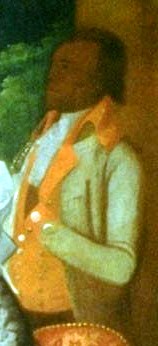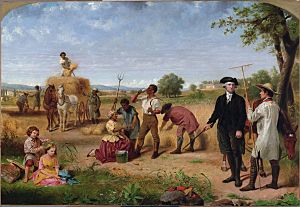List of enslaved people of Mount Vernon facts for kids
Many African Americans were enslaved at Mount Vernon, the large farm owned by George Washington in Fairfax County, Virginia. This was before the American Revolutionary War. These individuals have a rich and important history. For example, William Costin bravely challenged unfair laws in Washington D.C. Oney Judge and Hercules Posey were talented chefs at the President's home in Philadelphia. Posey was even the head chef! William Lee was George Washington's personal assistant and was often by his side. He became one of the most well-known enslaved people in early America. Sarah Johnson lived at Mount Vernon for over 50 years, first enslaved and later free. She eventually owned her own farm and became part of the Mount Vernon Ladies' Association.
Other notable people include Christopher Steele, a house servant who escaped but returned to Washington's side before his death. Harry Washington was born in Gambia and was brought to America as an enslaved person by George Washington. During the American Revolutionary War, Harry escaped. He then served with the British army in a group called the Black Company of Pioneers. After the war, he was among the Black Loyalists who settled in Nova Scotia. There, he married Jenny, another formerly enslaved American. In 1792, Harry joined about 1200 free people who moved to Sierra Leone to start a new colony. Deborah Squash also escaped from Mount Vernon in 1781. She was one of 3,000 Black individuals who sailed to Nova Scotia on a British ship, recorded in the Book of Negroes.
Contents
Stories of Enslaved People at Mount Vernon
Caroline Branham
Caroline Branham (1764–1843) was born at Mount Vernon. Her mother was enslaved by Daniel Parke Custis, who was Martha Washington's first husband. When Martha married George Washington, Caroline and her mother came to live at Mount Vernon. Caroline had nine children. Eight of them were with her husband, Peter Hardiman, who was a groomsman. Another child, Lucy, is believed to be the daughter of George Washington Parke Custis, Martha's grandson. He became Caroline's enslaver after Martha's death. Besides her house duties, Caroline made clothes for the enslaved people at Mount Vernon. She was able to arrange for her grandson, Lucy's son, to be freed. This happened in exchange for her sharing her story with a writer named Jared Sparks.
William Costin
William Costin (around 1780 - May 31, 1842) was born to an enslaved woman at Mount Vernon. He became a well-known African-American activist and scholar. He successfully challenged unfair laws in Washington D.C. in the Circuit Court of the District of Columbia.
West Ford
West Ford (around 1784 – 1863) was a mixed-race man who helped care for the Mount Vernon estate. He arrived at Mount Vernon in 1802. He was enslaved until 1805, when he became a free man. He continued to work at Mount Vernon as a free person until 1860. He shared many stories about his life at Mount Vernon through spoken history.
Sarah Johnson
Sarah Johnson (September 29, 1844 – January 25, 1920) was an African American woman born into slavery at Mount Vernon. She worked as a domestic servant, cleaning and caring for the mansion. Through this work, she learned a lot about all the furnishings in the house. After the American Civil War ended, she was hired by the Mount Vernon Ladies' Association. She eventually became a council member of the organization. Sarah and her husband, Nathan, saved their money. They bought four acres of Mount Vernon land to start their own small farm. The book Sarah Johnson's Mount Vernon (2008) tells her life story and describes the many people who lived at Mount Vernon.
Oney Judge
Oney Judge (around 1773 – February 25, 1848), also known as Ona Judge Staines, was a mixed-race woman enslaved by the Washington family. She first lived at Mount Vernon. Later, when George Washington became president, she moved with the family to the President's House in Philadelphia, which was then the nation's capital. When she was 23, she learned that Martha Washington planned to give her to her niece. Oney then escaped and fled to New Hampshire. There, she married, had children, and became a Christian. The Washington family never officially freed her. However, they did not want to risk public anger by forcing her to return. After many years of trying to persuade her to come back quietly, they eventually let her be.
William Lee
William Lee (around 1750–1810), also called Billy or Will Lee, was enslaved by George Washington. He served as Washington's personal assistant. He was the only one of Washington's enslaved people who was freed right away in Washington's will. William Lee was by Washington's side throughout the American Revolutionary War. He was sometimes shown next to Washington in paintings. Because of this, Lee became one of the most well-known African Americans of his time.
Hercules Posey
Hercules Posey (1748 – May 15, 1812) was an African American enslaved by the Washington family. He worked as the family's head chef for many years. He first worked at Mount Vernon. Later, after George Washington became president, Hercules moved with the family to the President's House in Philadelphia. He worked there alongside Oney Judge. Around 1797, Posey escaped and fled to New York. He lived there until his death in 1812. He was legally freed when Washington died in 1799. However, his children remained enslaved by Washington's wife, Martha Washington.
Christopher Sheels

Christopher Sheels (born around 1774, Mount Vernon, Virginia – year and place of death unknown) was an enslaved house servant at George Washington's farm, Mount Vernon. As a teenager, he worked as Washington's personal attendant in the presidential homes in New York City (1789–90) and Philadelphia (1790–91). In September 1799, Washington stopped Sheels from trying to escape from Mount Vernon. Three months later, Christopher was present at the former president's deathbed.
Deborah Squash
Deborah Squash (born around 1763–1765) was enslaved at George Washington's Mount Vernon farm before she escaped in 1781. She went to New Amsterdam, which was the main base for the British during the American Revolution. At the end of the war, she was one of 3,000 Black individuals listed in the Book of Negroes who sailed on a British ship to Nova Scotia.
Harry Washington
Harry Washington (around 1740–1800) was born in Gambia. He was captured during a war and sold into slavery. George Washington then purchased him. During the American Revolutionary War, Harry Washington escaped from slavery in Virginia. He served as a corporal in the Black Company of Pioneers, which was part of a British artillery group. After the war, he was among the Black Loyalists who were resettled by the British in Nova Scotia. They were given land there. Harry Washington married Jenny, another formerly enslaved American, in Nova Scotia. In 1792, he joined nearly 1200 free people who moved to Sierra Leone. They created a colony of free people of color there.
Images for kids
See also





